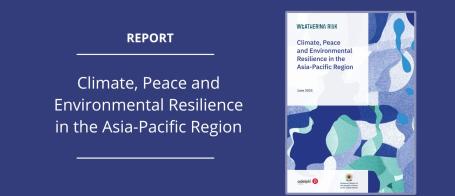Climate, Peace and Environmental Resilience in the Asia-Pacific Region

Home to approximately 60 per cent of the global population, the Asia-Pacific region faces some of the most diverse and complex climate-related security risks globally. Regional cooperation will be essential to avert the worst impacts of the crisis on populations. In addition, tackling shared risks in solidarity provides a key opportunity to enhance the Asia-Pacific region’s collective strength.
Supported by the Republic of Korea, this report analyses climate-related risks to peace, stability and development across five key subregions: Pacific Island Countries, South Asia, Central Asia and Afghanistan, Southeast Asia, and East Asia. It identifies both region-specific and cross-cutting entry points for action, offering a practical framework to enhance climate, peace and environmental resilience across the Asia-Pacific region.
Key insights include:
- Pacific Island Countries
- Land availability and usability are threatened by climate change, particularly by rising sea levels, with risk of submergence.
- Disasters are costing billions in economic damages, with climate and environmental hazards expected to significantly undermine incomes.
- Climate-induced migration and displacement are increasing, with relocation likely necessary for significant numbers of Pacific Islanders.
- South Asia
- Climate change, environmental degradation and political tensions could exacerbate competition for transboundary resources, straining fragile interstate relations and risking conflict.
- Changing weather patterns are creating significant, adverse effects on agricultural sectors, undermining livelihoods and food security.
- Climate-induced migration and displacement will continue to rise, with migrants and IDPs facing further risks.
- Uptakes in critical mineral mining could boost economies but also drive instability and insecurity.
- Central Asia and Afghanistan
- Climate change, environmental degradation and infrastructure decay are increasing competition for transboundary water resources, leading to conflict.
- Changing river flows, drought, and other climate and environmental hazards are likely to severely impact agricultural sectors, undermining livelihoods, food security and increasing migration.
- Climate and environmental impacts on livelihoods could see farmers turn to illicit economies, fuelling insecurity and conflict.
- Critical mineral reserves hold potential for economic development as well as geopolitical, social and environmental risks.
- Southeast Asia
- Extreme weather events are likely to affect millions annually, seeing knock-on security impacts in fragile and conflict-affected contexts.
- Increased temperatures, environmental degradation and exploitation could increase conflict over fish stocks.
- Reductions in water availability in rivers could see widespread impacts on livelihoods and food security.
- Critical mineral production threatens adverse social and environmental impacts.
- East Asia
- Extreme weather events and disasters are likely to increase regionally, with the greatest risks for the most vulnerable.
- Critical mineral supply chains, necessary to fuel the green-energy transition, can also present challenges.
The report outlines three priority action areas to enhance climate, peace and environmental resilience across the region at large:
- Ensure strategies to develop climate, peace and environmental resilience are tailored to local, national and subregional contexts.
- Promote interstate cooperation to overcome climate-related risks and enhance regional strength.
- Broaden the approach to climate-related risks and actions to overcome them in international institutions.
Share on

